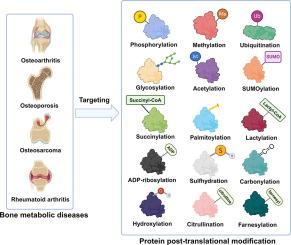靶向翻译后修饰:对骨代谢疾病的新见解
IF 13
1区 综合性期刊
Q1 MULTIDISCIPLINARY SCIENCES
引用次数: 0
摘要
骨代谢性疾病是一组以骨量和骨骼代谢异常改变为特征的疾病,通常由氧化应激、营养缺乏和各种其他病因引起。翻译后修饰(Post-translational modification, PTM)是一种重要的蛋白调控机制,在骨代谢性疾病的发病机制中起着关键作用。虽然以往的研究主要集中在常见PTMs的个体调控功能,如磷酸化、甲基化和泛素化,但它们在很大程度上忽视了不同PTMs之间的动态相互作用和串扰。近年来,越来越多的新型ptm与骨代谢性疾病的进展有关;然而,对其潜在机制和相互关系的全面分析仍然有限。因此,有必要对PTMs在骨代谢疾病中的作用和相互作用进行系统和最新的综述。本文系统介绍了不同类型PTMs的磷酸化、甲基化、泛素化、糖基化、乙酰化、sumo酰化、琥珀酰化、棕榈酰化、乳酸化、adp -核糖基化、巯基化、羰基化、羟基化、瓜氨酸化、法尼基化等基本过程,并对这些PTMs调控骨代谢性疾病发生的机制和相互作用进行了综述。综述的关键科学概念本综述主要关注三个关键概念。首先,它强调了与骨代谢疾病的病理过程有关的ptm。其次,研究不同ptm在骨代谢性疾病中的调控机制和相互作用。第三,它讨论了异常的ptm如何通过调节各种信号通路破坏骨代谢稳态,导致细胞功能障碍,参与骨关节炎、骨质疏松症、骨肉瘤和类风湿性关节炎的发生和发展。因此,深入研究PTM在骨代谢性疾病中的作用机制,有助于发现新的调控靶点,为制定更有效的治疗策略提供理论基础。本文章由计算机程序翻译,如有差异,请以英文原文为准。

Targeting post-translational modifications: novel insights into bone metabolic diseases
Background
Bone metabolic diseases constitute a group of disorders characterized by abnormal alterations in bone mass and skeletal metabolism, often resulting from oxidative stress, nutritional deficiencies, and various other etiological factors. Post-translational modification (PTM), a critical mechanism of protein regulation, plays a pivotal role in the pathogenesis of bone metabolic diseases. While previous reviews have primarily focused on the individual regulatory functions of common PTMs, such as phosphorylation, methylation, and ubiquitination, they have largely overlooked the dynamic interactions and cross talk among different PTMs. In recent years, an increasing number of novel PTMs have been implicated in the progression of bone metabolic diseases; however, comprehensive analyses of their underlying mechanisms and interrelationships remain limited. Therefore, a systematic and updated review of the roles and interplay of PTMs in bone metabolic diseases is warranted.Aim of review
This review systematically introduced the basic processes of different types of PTMs, including phosphorylation, methylation, ubiquitination, glycosylation, acetylation, SUMOylation, succinylation, palmitoylation, lactylation, ADP-ribosylation, sulfhydration, carbonylation, hydroxylation, citrullination, and farnesylation, and summarized underlying mechanisms and cross talks among these PTMs in regulating the development of bone metabolic diseases.Key scientific concepts of review
This review focuses on three key concepts. First, it highlights PTMs that have been implicated in the pathological process of bone metabolic diseases. Second, it examines the regulatory mechanisms and cross talks among different PTMs in bone metabolic diseases. Third, it discusses how aberrant PTMs can disrupt bone metabolic homeostasis by regulating various signaling pathways, leading to cellular dysfunction involved in the onset and development of osteoarthritis, osteoporosis, osteosarcoma, and rheumatoid arthritis. Therefore, an in-depth study of the PTM mechanisms in bone metabolic diseases may facilitate the identification of novel regulatory targets and provide a theoretical foundation for the development of more effective therapeutic strategies.求助全文
通过发布文献求助,成功后即可免费获取论文全文。
去求助
来源期刊

Journal of Advanced Research
Multidisciplinary-Multidisciplinary
CiteScore
21.60
自引率
0.90%
发文量
280
审稿时长
12 weeks
期刊介绍:
Journal of Advanced Research (J. Adv. Res.) is an applied/natural sciences, peer-reviewed journal that focuses on interdisciplinary research. The journal aims to contribute to applied research and knowledge worldwide through the publication of original and high-quality research articles in the fields of Medicine, Pharmaceutical Sciences, Dentistry, Physical Therapy, Veterinary Medicine, and Basic and Biological Sciences.
The following abstracting and indexing services cover the Journal of Advanced Research: PubMed/Medline, Essential Science Indicators, Web of Science, Scopus, PubMed Central, PubMed, Science Citation Index Expanded, Directory of Open Access Journals (DOAJ), and INSPEC.
 求助内容:
求助内容: 应助结果提醒方式:
应助结果提醒方式:


